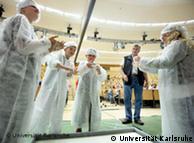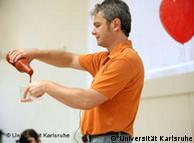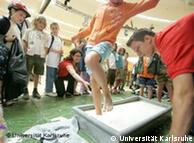上週﹐身為卡耐基-梅隆大學(Carnegie-Mellon University)電腦科學教授的鮑什在向400名學生和同事發表演講時提到了這件事。
他說﹐如果你的孩子也像我當年那樣﹐想在臥室里塗塗畫畫的﹐就讓他們去畫吧。別擔心你的房子轉手的時候售價會受到影響。
他的演講幽默生動﹐讓我們分享了他的人生體驗﹐這也將是他的最後一次演講﹐因為他身患胰腺癌﹐估計只剩下幾個月的時間了。
此次演講結束後 ﹐他唯一的想法就是安靜地同妻子和三個年幼的孩子度過他的餘生。他根本沒有想到自己的那次演講會引發一陣旋風。演講的視頻片斷在網上播出後﹐數以千計的人 同他聯繫﹐表示他給他們的生活帶來了深刻影響。許多人被他的演講感動得熱淚盈眶﹐並表示要立刻採取行動。各地的父母都表示﹐會允許孩子盡情地在臥室牆壁上 塗鴉。
內華達州的卡羅•卡索耳(Carol Castle)在委托我轉發給鮑什的電子郵件中寫道﹕等我回到家裡﹐我會讓女兒給她房間牆壁塗上她喜歡的粉紅色﹐而不是我考慮今後能賣個好價錢的香草白。
人 們想讓鮑什知道﹐他的講話讓他們不再自怨自艾﹐幫助他們走出離婚的陰影﹐或更加重視家庭。一位女性寫道﹐鮑什的演講給了她擺脫惡習的勇氣。身患重症的病人 寫道﹐他們也會像46歲的鮑什那樣繼續生活。鮑什在演講中說﹐我就要死了﹐但我依然很開心。我將依舊開心地度過每一天﹐因為我不知道還有其他的生活方式。
南達科他州的唐•福蘭肯菲爾德(Don Frankenfeld)說﹐這次演講是他多年來度過的最難忘的時刻。許多人也都有這種感覺。
ABC News在《早安美國》節目中播出了有關鮑什的內容﹐並把他評為本週人物。其它媒體也紛紛對他進行採訪。全球有數百個博客發文將他稱為新的英雄。標題都非常煽情:“有史以來最好的演講”、“我經歷的最重要的事情”、“蘭迪•鮑什﹐值得你付出每一秒”等等。
鮑什在演講中說過﹐磚牆的存在是有道理的﹐它讓我們有機會表明我們是多麼想擁有一些東西。許多網站都登載了這樣的段落。一些網站還加入了牆的照片。同樣﹐牧師們在這個週末佈道時也在提到了他的磚牆理論。
一 些人將他的演講同盧•格里格(Lou Gehrig)的“最幸運的男人”的演講相提並論。一個15歲的女孩告訴鮑什﹐她的AP英語課堂上一直在分析格里格的演講﹐“我感覺﹐幾年後就會分析你的 演講。” 伊利諾伊州內珀維爾的Central高中演講團就計劃在參賽時讓一個學生演講鮑什的內容。
鮑什迷們不斷將他的演講發給朋友們。紐約一家投資銀行的技術部經理馬克•費弗爾(Mark Pfeifer)說﹐我是一個很憤世嫉俗的人﹐經常提醒別人不要給我發那種自我感覺良好的煽情文章。但蘭迪•鮑什的演講讓我非常感動﹐我也打算轉發給他人。
在邁阿密﹐退休人員羅納德•特拉讚菲爾德(Ronald Trazenfeld)將演講內容發給朋友們﹐建議他們不要總抱怨糟糕的服務和低劣的商品質量﹐而是應該擁抱他們所愛的人。
在 演講要結束時﹐鮑什談到在他獲得博士學位後﹐他的母親如何開著玩笑介紹他:這是我的兒子。他是一名“doctor”(博士)﹐不過不是能幫人(治病)的 doctor(醫生)。這只是句玩笑話﹐不過不少人聽到這個之後卻像加州的切瑞•戴維斯(Cheryl Davis)那樣讚美鮑什說﹕你就是能幫助人們的doctor。
在報告廳里給400人作的演講被數百萬人廣為傳頌﹐這讓鮑什感到有些手足無措。不過﹐他一如既往地保持著他的幽默感。他說﹐人們能感到自己非常了不起、對他人很有激勵作用的次數是有限的﹔看起來我還沒有達到那個上限。
卡耐基-梅隆大學計劃對鮑什予以褒獎。作為一位有藝術氣質的技術專家﹐他是學校里的一座連接藝術與科學的橋梁。校園里一棟正在建設的電腦科學樓將有一座步行天橋通往藝術樓。這座橋將被命名為蘭迪•鮑什紀念橋。
卡 耐基-梅隆大學校長傑瑞德•柯亨(Jared Cohon)在宣佈這一榮譽時幽默地說﹐根據你的演講﹐我們正考慮在橋的兩頭都砌上磚牆。他說﹕鮑什﹐將來的學生和教職員可能不認識你﹐但他們會走過這座 橋﹐看到你的名字﹐會向我們這些認識你的人問起你。我們會把一切告訴他們。
鮑什要求卡耐基-梅隆大學不要保留他最後一次演講的版權﹐而是讓它成為公共資源。而這次演講將讓他的精神遺產──還有那座步行天橋──留在這個世界上。
Jeffrey Zaslow
The Professor's Manifesto: What It Meant To ReadersAs a boy, Randy Pausch painted an elevator door, a submarine and mathematical formulas on his bedroom walls. His parents let him do it, encouraging his creativity.
Last week, Dr. Pausch, a computer-science professor at Carnegie Mellon University, told this story in a lecture to 400 students and colleagues.
'If your kids want to paint their bedrooms, as a favor to me, let 'em do it,' he said. 'Don't worry about resale values.'
As I wrote last week, his talk was a riveting and rollicking journey through the lessons of his life. It was also his last lecture, since he has pancreatic cancer and expects to live for just a few months.
After he spoke, his only plans were to quietly spend whatever time he has left with his wife and three young children. He never imagined the whirlwind that would envelop him. As video clips of his speech spread across the Internet, thousands of people contacted him to say he had made a profound impact on their lives. Many were moved to tears by his words -- and moved to action. Parents everywhere vowed to let their kids do what they'd like on their bedroom walls.
'I am going to go right home and let my daughter paint her wall the bright pink she has been desiring instead of the 'resalable' vanilla I wanted,' Carol Castle of Spring Creek, Nev., wrote to me in an email to forward to Dr. Pausch.
People wanted Dr. Pausch to know that his talk had inspired them to quit pitying themselves, or to move on from divorces, or to pay more attention to their families. One woman wrote that his words had given her the strength to leave an abusive relationship. And terminally ill people wrote that they would try to live their lives as the 46-year-old Dr. Pausch is living his. 'I'm dying and I'm having fun,' he said in the lecture. 'And I'm going to keep having fun every day, because there's no other way to play it.'
For Don Frankenfeld of Rapid City, S.D., watching the full lecture was 'the best hour I have spent in years.' Many echoed that sentiment.
ABC News, which featured Dr. Pausch on 'Good Morning America,' named him its 'Person of the Week.' Other media descended on him. And hundreds of bloggers world-wide wrote essays celebrating him as their new hero. Their headlines were effusive: 'Best Lecture Ever,' 'The Most Important Thing I've Ever Seen,' 'Randy Pausch, Worth Every Second.'
In his lecture, Dr. Pausch had said, 'Brick walls are there for a reason. They let us prove how badly we want things.' Scores of Web sites now feature those words. Some include photos of brick walls for emphasis. Meanwhile, rabbis and ministers shared his brick-wall metaphor in sermons this past weekend.
Some compared the lecture to Lou Gehrig's 'Luckiest Man Alive' speech. A 15-year-old girl told Dr. Pausch that her AP English class had been analyzing the Gehrig speech, and 'I have a feeling that we'll be analyzing your speech for years to come.' Already, the Naperville, Ill., Central High School speech team plans to have a student deliver the Pausch speech word for word in competition.
As Dr. Pausch's fans emailed his speech to friends, some were sheepish. 'I am a deeply cynical person who reminds people frequently not to send me those sappy feel-good emails,' wrote Mark Pfeifer, a technology manager at a New York investment bank. 'Randy Pausch's lecture moved me deeply, and I intend to forward it on.'
In Miami, retiree Ronald Trazenfeld emailed the lecture to friends with a note to 'stop complaining about bad service and shoddy merchandise.' He suggested they instead hug someone they love.
Near the end of his lecture, Dr. Pausch had talked about earning his Ph.D., and how his mother would kiddingly introduce him: 'This is my son. He's a doctor, but not the kind who helps people.' It was a laugh line, but it led dozens of people to reassure Dr. Pausch: 'You ARE the kind of doctor who helps people,' wrote Cheryl Davis of Oakland, Calif.
Dr. Pausch feels overwhelmed and moved that what began in a lecture hall with 400 people is being experienced by millions. Still, he has retained his sense of humor. 'There's a limit to how many times you can read how great you are and what an inspiration you are,' he says, 'but I'm not there yet.'
Carnegie Mellon has a plan to honor Dr. Pausch. As a techie with the heart of a performer, he was a link between arts and sciences on campus. A new computer-science building is being built, and a footbridge will connect it to the arts building. The bridge will be named the Randy Pausch Memorial Footbridge.
'Based on your talk, we're thinking of putting a brick wall on either end,' joked the university's president, Jared Cohon, announcing the honor. He went on to say: 'Randy, there will be generations of students and faculty who will not know you, but they will cross that bridge and see your name and they'll ask those of us who did know you. And we will tell them.'
Dr. Pausch has asked Carnegie Mellon not to copyright his last lecture, and instead to leave it in the public domain. It will remain his legacy, and his footbridge, to the world.
Jeffrey Zaslow














